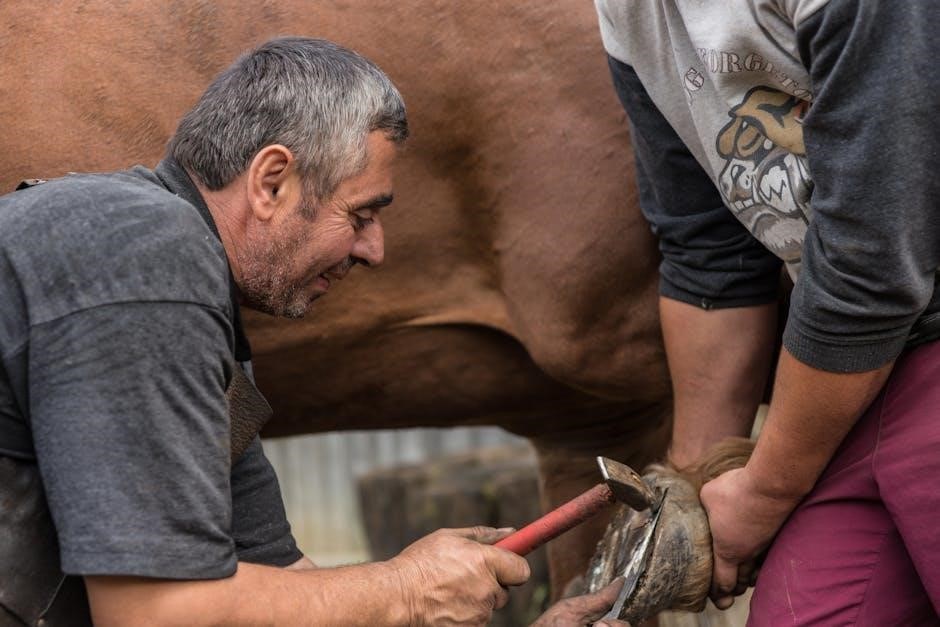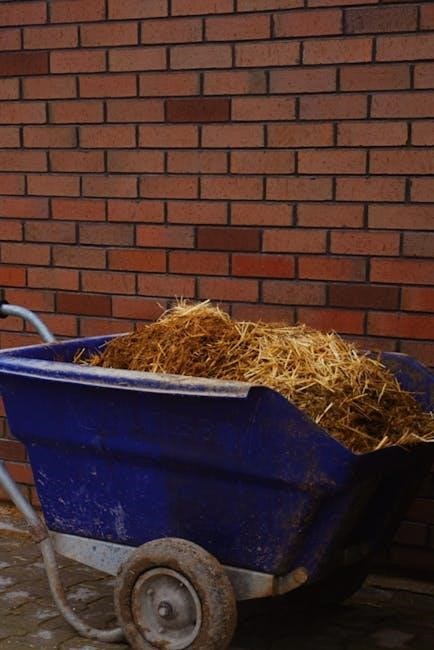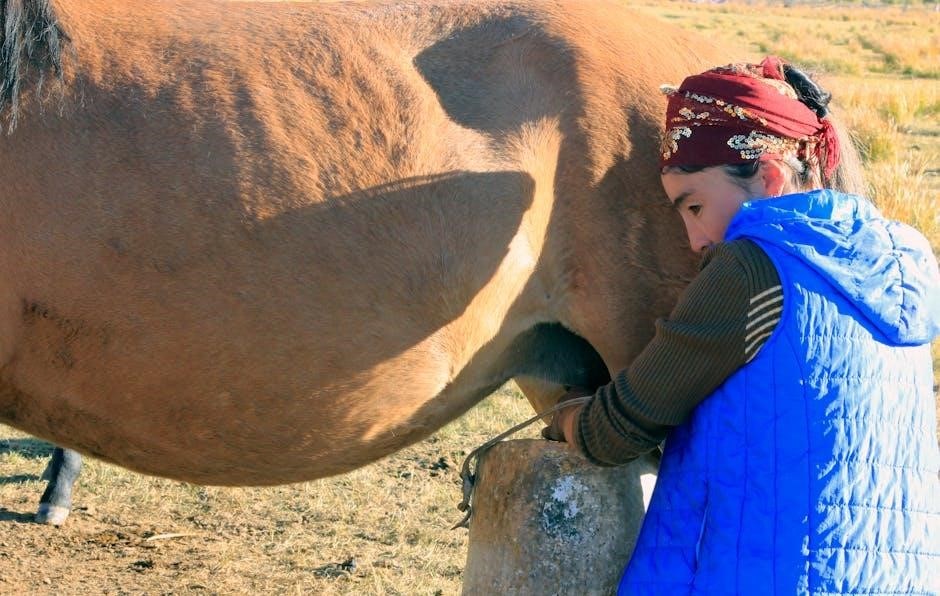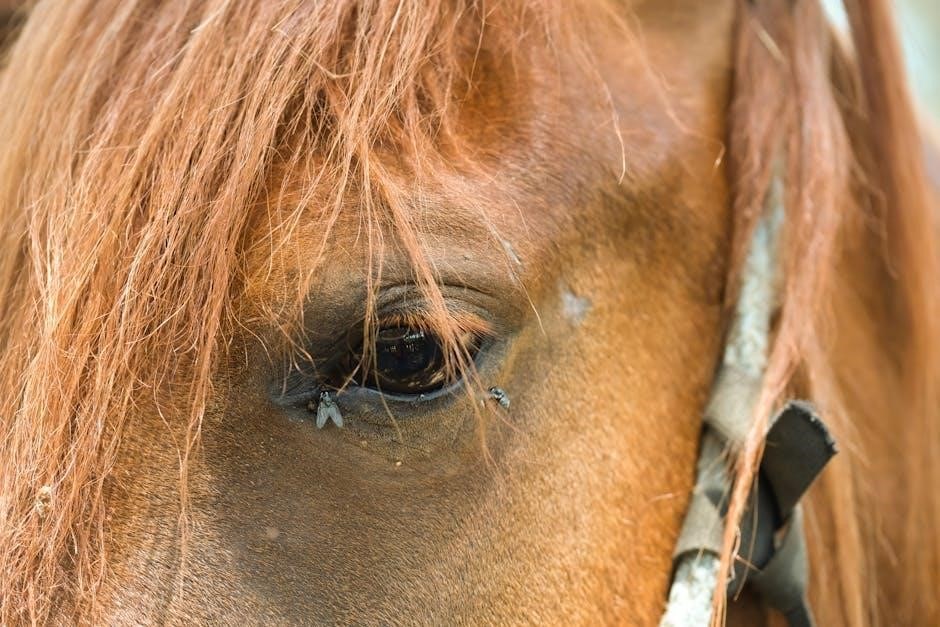Welcome to the Troy Bilt Horse Tiller Manual, your comprehensive guide to understanding and using your tiller effectively. This manual covers setup, operation, maintenance, troubleshooting, safety, and accessories, ensuring optimal performance and safety.
1.1 Overview of the Manual
Welcome to the Troy Bilt Horse Tiller Manual, your essential guide for operating, maintaining, and troubleshooting your tiller. This manual is designed to provide clear, step-by-step instructions to help you maximize the performance of your equipment. It covers everything from initial setup and safety precautions to routine maintenance and repair. Whether you’re a seasoned gardener or a first-time user, this manual ensures you understand how to use your tiller safely and effectively. Key topics include assembly, operation, maintenance, and troubleshooting, along with tips for getting the most out of your machine. By following the guidelines outlined in this manual, you’ll be able to keep your Troy Bilt Horse Tiller in optimal condition and achieve professional-grade results in your garden.
1.2 History of the Troy Bilt Horse Tiller

The Troy Bilt Horse Tiller, often referred to as the “HORSE MODEL,” has a long-standing reputation as a powerful and reliable gardening tool. Introduced as part of the Troy-Bilt family, this tiller was designed to handle demanding tasks with ease, making it a favorite among gardeners and landscapers. Known for its durability and robust performance, the Horse Tiller has evolved over the years, incorporating advancements in design and functionality while maintaining its core strength. Originally developed to tackle tough soil and heavy-duty gardening projects, it has become a trusted companion for those seeking professional-grade results. With a legacy rooted in quality and innovation, the Troy Bilt Horse Tiller continues to be a testament to the brand’s commitment to excellence in gardening equipment.
1.3 Key Features and Benefits
The Troy Bilt Horse Tiller is renowned for its powerful performance and versatility, making it a top choice for gardeners. Its robust design and high-quality components ensure durability and reliability. With features like a strong engine and adjustable tilling depth, it excels at breaking up tough soil and preparing garden beds efficiently. The tiller also offers ease of use, with intuitive controls and ergonomic handles for comfortable operation. Safety features, such as protective gear recommendations and clear operating instructions, prioritize user well-being. Additionally, the tiller supports a range of approved accessories, enhancing its functionality for various tasks. Its ability to handle heavy-duty projects while maintaining precision makes it a valuable tool for both professionals and home gardeners, ensuring optimal results with minimal effort.

Safety Instructions
Safety is crucial when operating the Troy Bilt Horse Tiller. Always read and follow the manual’s guidelines, wear protective gear, and ensure proper precautions to avoid accidents.
2.1 General Safety Guidelines
Always read and follow the safety rules and instructions provided in this manual before operating the Troy Bilt Horse Tiller. Ensure the area is clear of debris, children, and pets. Wear protective gear, including safety glasses, gloves, and sturdy footwear. Never operate the tiller while under the influence of alcohol or drugs. Keep loose clothing and long hair tied back to avoid entanglement. Ensure all guards and shields are in place to prevent exposure to moving parts. Familiarize yourself with the controls and their functions before starting the engine. Operate the tiller only in well-ventilated areas and avoid breathing dust or fumes. Never leave the tiller unattended while it is running. Follow all local regulations and safety standards. Proper handling and adherence to these guidelines will help prevent accidents and ensure safe operation.
2.2 Protective Gear and Precautions
Always wear appropriate protective gear when operating the Troy Bilt Horse Tiller, including safety glasses, gloves, and sturdy, non-slip footwear. Avoid loose clothing or jewelry that could get caught in moving parts. Keep long hair tied back to prevent entanglement. Ensure all guards and shields are securely in place to protect against flying debris. Use the tiller only in well-ventilated areas to avoid inhaling dust or fumes. Avoid operating the tiller in wet conditions or on uneven terrain to reduce the risk of slipping or losing control. Never allow children or pets near the operating area. Proper precautions and protective gear minimize risks and ensure a safer working environment while using your Troy Bilt Horse Tiller.
2.3 Operating Warnings and Cautions
Always adhere to the operating warnings and cautions outlined in the Troy Bilt Horse Tiller Manual to ensure safe and effective use. Never leave the tiller unattended while it is running, as this can lead to accidents. Keep children and pets at a safe distance from the operating area. Avoid operating the tiller on steep slopes or uneven terrain, as this may cause loss of control. Do not modify or tamper with the tiller’s safety features, as this can compromise its operation. Never use the tiller in wet conditions or where there is standing water, as this can increase the risk of electrical shock or slipping. Be cautious of underground obstacles and power lines. Always follow the recommended operating procedures and guidelines provided in the manual to ensure safe and efficient tilling. Proper adherence to these warnings and cautions is essential for maintaining safety and prolonging the life of your Troy Bilt Horse Tiller.

Assembly and Setup
Begin by carefully unboxing and inventorying all parts. Follow the manual’s step-by-step guide to attach handles and accessories securely. Ensure proper assembly for safe operation.
3.1 Unboxing and Inventory of Parts
When unboxing your Troy-Bilt Horse Tiller, carefully inspect each component for damage. Verify the presence of all listed parts, including the tiller frame, tines, handles, and hardware. Cross-reference the inventory list provided in the manual to ensure nothing is missing. Pay special attention to smaller items like bolts, washers, and grease fittings, as these are essential for assembly. If any parts are damaged or missing, contact Troy-Bilt customer support immediately. Proper inventory ensures a smooth assembly process and prevents delays. Organize the parts logically, grouping similar components together to streamline the setup.
3.2 Attaching Handles and Accessories
Begin by attaching the handles according to the manual’s instructions. Align the handle brackets with the tiller frame and secure them using the provided bolts and washers. Tighten firmly but avoid overtightening. Next, install any optional accessories, such as a tine shield or cultivator attachment, ensuring they fit properly and are aligned with the tiller’s design. Refer to the diagrams in the manual for precise placement. Once all parts are securely attached, double-check the connections to ensure stability and safety. Finally, test the handles and accessories by gently moving the tiller to confirm smooth operation. Proper assembly ensures optimal performance and prevents potential damage during use.
3.3 Checking and Adding Fluids
Regularly check the engine oil and transmission fluid levels to ensure proper lubrication and functionality. Locate the oil dipstick near the engine and wipe it clean before reinserting to get an accurate reading. For the transmission fluid, refer to the manual for the correct reservoir location. If levels are low, add the recommended type of oil or fluid as specified in the manual. Ensure the tiller is on a level surface and the engine is cool before checking fluids. Always use the fluids recommended by Troy-Bilt to prevent damage. If unsure, consult the manual or contact a certified technician; Proper fluid maintenance ensures smooth operation and extends the life of your tiller. Regular checks help prevent engine damage and maintain optimal performance. Always follow safety guidelines when handling fluids and machinery.

Operating the Tiller
Operating the Troy Bilt Horse Tiller involves starting the engine, engaging the tines, and adjusting speed. Ensure smooth control and safe handling for effective gardening.
4.1 Starting the Engine
Starting the Troy Bilt Horse Tiller’s engine is a straightforward process that ensures your machine is ready for tilling. First, ensure the tiller is on level ground and the transmission is in neutral. Prime the engine by pressing the primer bulb 2-3 times until it feels firm. Next, move the choke to the “start” position and pull the recoil starter handle slowly until resistance is felt, then pull sharply. Allow the engine to warm up for a few seconds before adjusting the choke to the “run” position. Always wear safety gear, including gloves and eye protection, when starting and operating the tiller. Refer to your owner’s manual for specific instructions tailored to your model.
4.2 Adjusting Tilling Depth
Adjusting the tilling depth on your Troy Bilt Horse Tiller ensures effective soil preparation. Locate the depth control lever, typically near the handlebars. Move the lever up for deeper tilling and down for shallower tilling. Always ensure the tiller is on level ground for consistent depth. Turn off the engine before making adjustments for safety. After setting the desired depth, test by tilling a small area and adjust as needed. Refer to the manual for specific guidelines on soil types and tine usage. Secure the lever after adjustment to prevent accidental changes. Regularly lubricate and maintain the depth adjustment mechanism for smooth operation. If unsure, consult the manual or seek additional resources for clarification.
4.3 Navigating Different Soil Types
Navigating different soil types with your Troy Bilt Horse Tiller requires careful adjustment and attention to soil conditions. For soft, loose soil, maintain steady forward momentum and keep the tines engaged at the recommended depth. In hard or clay soil, reduce your speed and make shallow passes, gradually increasing depth as needed. Rocky or uneven terrain demands caution; disengage the tines and manually clear debris before resuming. For sandy or light soil, maintain consistent tilling depth to avoid overworking the soil. Always moisten dry soil before tilling to improve efficiency. Adjust the tiller’s depth control lever to suit the soil type, ensuring optimal results without damaging the machine. Regularly inspect the tines for wear or blockages and clean them as needed. This ensures smooth operation across various soil conditions.

Maintenance and Repair
Regular maintenance ensures optimal performance and longevity of your Troy Bilt Horse Tiller. Follow routine checks, lubrication schedules, and oil change guidelines to keep it running smoothly.
5.1 Routine Maintenance Checks

Regular maintenance is essential to ensure your Troy Bilt Horse Tiller operates efficiently and lasts longer. Begin by checking the oil level before each use, ensuring it meets the recommended grade and viscosity specified in the manual. Inspect the tires for proper inflation and wear, as uneven or underinflated tires can affect performance. Examine the tines and blades for damage or dullness, sharpening or replacing them as needed. Tighten all bolts and screws to prevent loosening during operation. Lubricate moving parts, such as gears and hinges, to reduce friction and wear. Additionally, check the air filter for cleanliness and replace it if clogged to maintain proper engine airflow. Finally, inspect the transmission and belts for signs of wear or misalignment. By following these routine checks, you can prevent unexpected breakdowns and keep your tiller in optimal condition.
5.2 Lubrication and Oil Changes
Regular lubrication and oil changes are crucial for maintaining the performance and longevity of your Troy Bilt Horse Tiller. Always use the recommended oil grade and viscosity, as specified in the manual, to ensure proper engine lubrication. Before starting, warm up the engine slightly to allow the oil to flow freely. To change the oil, drain the old oil into a pan, then replace the filter and refill with fresh oil. Check the manual for the correct torque specification when tightening the drain plug. Additionally, lubricate all moving parts, such as the transmission gears and pivot points, using a high-quality grease. Regular oil changes and lubrication will help prevent overheating, wear, and tear on critical components, ensuring your tiller runs smoothly for years to come.
Troubleshooting Common Issues
This section addresses common problems with the Troy Bilt Horse Tiller, such as engine issues, tine malfunctions, and transmission faults, helping you identify and resolve them efficiently.

6.1 Engine Problems

Engine issues in the Troy Bilt Horse Tiller can often be traced to fuel quality, air filter blockages, or spark plug problems. Frequent difficulties include failure to start, rough operation, or overheating. Inspect the fuel system for dirt or water contamination, and ensure the air filter is clean or replaced as needed. Spark plugs should be checked for wear or fouling, and replaced if necessary. Consult the manual for specific guidance on diagnosing and addressing these issues. Regular maintenance, such as oil changes and filter cleaning, can help prevent engine problems and ensure optimal performance.
6.2 Tine and Blade Issues
Tine and blade problems are common in the Troy Bilt Horse Tiller, often due to wear, dullness, or debris accumulation. Dull tines reduce efficiency, while bent or damaged blades can hinder proper soil engagement. Regularly inspect and clean tines and blades, removing dirt or debris that may interfere with operation. Sharpen tines as needed to maintain effectiveness, and replace worn or damaged parts promptly. Alignment issues can also occur, causing uneven tilling; adjust or replace tines to ensure proper balance. Always refer to the manual for specific instructions on maintenance and replacement procedures to keep your tiller performing at its best and extend its lifespan. Routine care can prevent these issues from escalating and ensure optimal tilling performance.

Accessories and Attachments
The Troy Bilt Horse Tiller supports various approved accessories, such as gear kits and attachments, to enhance functionality and tilling performance, ensuring compatibility and safety.
7.1 Approved Accessories
Approved accessories for the Troy Bilt Horse Tiller are designed to enhance its functionality and performance. These include gear kits, such as the CP11527, which are specifically engineered for the transmission system. Additional attachments like tine extensions or soil preparation kits can improve tilling efficiency. It’s essential to use only Troy-Bilt approved accessories to ensure compatibility and maintain safety standards. Using unauthorized attachments may void the warranty or compromise the tiller’s operation. Always refer to the manual or consult authorized dealers for a list of recommended accessories. These additions can help tailor the tiller to specific gardening needs, ensuring optimal results for various soil types and conditions. Properly installed accessories also extend the tiller’s versatility, making it a reliable tool for year-round garden maintenance.
Concluding, the Troy Bilt Horse Tiller Manual ensures safe operation and effective gardening. Regular maintenance and adherence to guidelines are crucial for optimal performance. Refer to the manual and manufacturer instructions for continued success.
8.1 Final Tips and Resources
To maximize your experience with the Troy Bilt Horse Tiller, ensure regular maintenance and adhere to safety guidelines. Store the tiller properly during the off-season and use only approved attachments. For complex repairs, consult the manual or contact authorized service centers. Keep the manual handy for quick reference and download updates from the official Troy Bilt website. Attend workshops or join gardening communities for additional insights and tips. Happy gardening!


